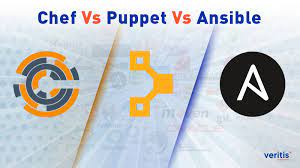Among the top contenders are Chef, Ansible, and Puppet, each with its own unique approach and philosophy. In this blog post, we'll go beyond the usual feature comparison and delve into the core philosophies that underpin these tools. By understanding their fundamental principles, you can make an informed decision about which one aligns best with your organization's goals and culture.
1. Chef: Embracing Infrastructure as Code (IaC)
Chef embodies the Infrastructure as Code (IaC) philosophy, where infrastructure is defined and managed through code. In Chef's world, infrastructure components are represented as code artifacts known as "recipes" and "cookbooks."
Recipes: These are small, reusable scripts that define a particular aspect of the infrastructure's configuration, such as installing software packages, configuring services, or managing files.
Cookbooks: Cookbooks are collections of related recipes, templates, and files that describe the desired state of the infrastructure. They allow you to create a cohesive and version-controlled representation of your infrastructure components.
Chef's idempotent nature ensures that the desired state of the infrastructure is maintained, making it ideal for environments where consistency is critical. The "desired state" is declared in code, and Chef continually converges the actual state to match it.
2. Ansible: Agentless Simplicity and Orchestration
Ansible takes a different approach by being agentless, meaning you don't need to install any additional software or agents on managed nodes. This simplicity in setup and execution is one of Ansible's hallmarks.
Ansible's philosophy is rooted in orchestration. It excels in executing tasks in parallel across multiple nodes, making it an excellent choice for rapid deployments and configuration changes. Ansible playbooks, written in YAML, define the tasks to be performed on target systems.
The approachable YAML syntax makes Ansible accessible to a wide range of users, even those without a deep programming background. It encourages collaboration between system administrators, developers, and other team members.
3. Puppet: The Declarative Puppet Manifests
Puppet adheres to a declarative approach to configuration management. Instead of specifying a sequence of steps to reach a desired state, you declare the desired end state, and Puppet takes care of the rest.
At the heart of Puppet are Puppet Manifests. These are files that describe the desired configuration of resources on a node. Puppet's domain-specific language (DSL) allows you to express the state of resources and their relationships. Puppet then enforces this desired state, ensuring that the infrastructure conforms to the declared configuration.
Puppet's approach is particularly suitable for managing complex and large-scale environments, as it provides a clear and concise expression of infrastructure configuration.
4. Use Cases and When to Choose Each Tool
The choice between Chef, Ansible, and Puppet depends on your specific use cases and organizational context.
-
Chef: Chef excels in environments where flexibility is key. If you have complex configurations or diverse infrastructure components, Chef's code-centric approach allows for fine-grained control.
-
Ansible: Ansible's simplicity and agentless architecture make it a great choice for rapidly changing environments. It's well-suited for tasks like application deployment, orchestration, and configuration management.
-
Puppet: Puppet is ideal for managing large-scale, complex infrastructures. If you have a stable environment with many nodes to manage and need a high level of predictability and control, Puppet's declarative model is a strong fit.
5. Community and Ecosystem
When choosing a configuration management tool, community support and ecosystem play a vital role.
- Chef, Ansible, and Puppet all have active communities, but their sizes and focus areas may vary. It's essential to evaluate the availability of community-contributed content, modules, and integrations relevant to your use case.
6. Learning Curve and Adoption Challenges
Consider the learning curve associated with each tool and potential adoption challenges. Training and skill development will be necessary for your team to use any of these tools effectively.
Chef's learning curve may be steeper due to its code-centric nature. Ansible's YAML-based syntax is relatively easy to grasp, while Puppet's declarative approach might require a mindset shift for those accustomed to procedural scripting.
However, each tool offers documentation, training resources, and active communities to help overcome these challenges.
7. The Future of Configuration Management
As the landscape of technology evolves, so do configuration management tools. In a cloud-native and containerized world, configuration management tools are adapting to new challenges and trends.
Kubernetes, microservices, and serverless architectures are changing the way infrastructure is managed. Configuration management tools are integrated with these technologies to provide seamless automation and orchestration.
Consider how Chef, Ansible, and Puppet are positioning themselves to meet the demands of this ever-changing landscape.
By understanding the core principles and philosophies that underpin these tools, you can make a choice that not only fits your immediate requirements but also sets you on a path for long-term success in your DevOps journey. Whether you choose Chef's code-centric approach, Ansible's agentless simplicity, or Puppet's declarative power, the ultimate goal is to achieve efficient, consistent, and automated infrastructure management.


No comments yet